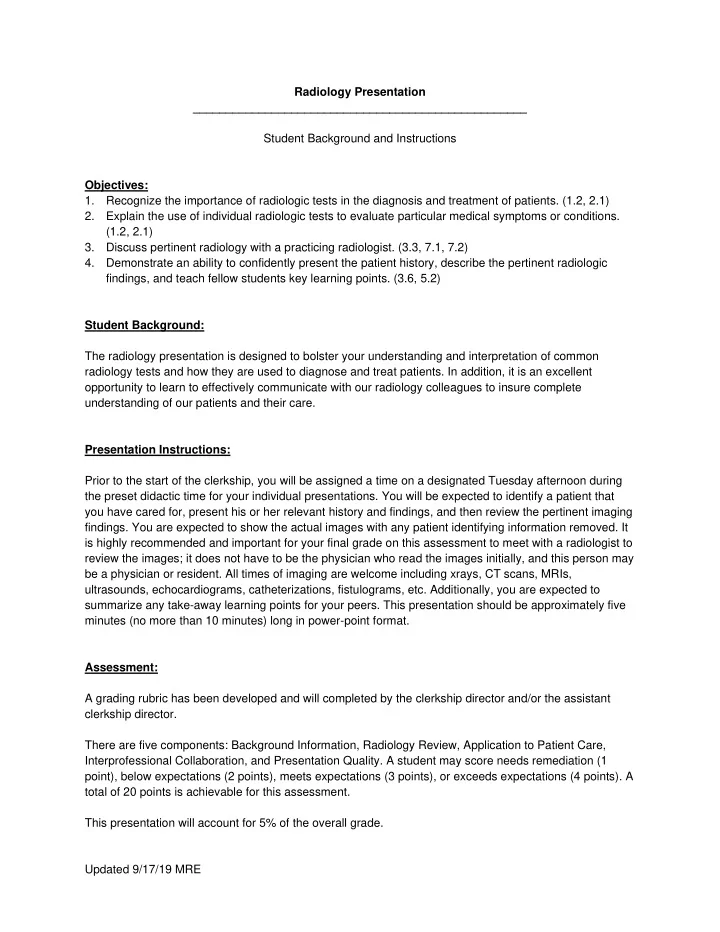

Radiology Presentation ___________________________________________________ Student Background and Instructions Objectives: 1. Recognize the importance of radiologic tests in the diagnosis and treatment of patients. (1.2, 2.1) 2. Explain the use of individual radiologic tests to evaluate particular medical symptoms or conditions. (1.2, 2.1) 3. Discuss pertinent radiology with a practicing radiologist. (3.3, 7.1, 7.2) 4. Demonstrate an ability to confidently present the patient history, describe the pertinent radiologic findings, and teach fellow students key learning points. (3.6, 5.2) Student Background: The radiology presentation is designed to bolster your understanding and interpretation of common radiology tests and how they are used to diagnose and treat patients. In addition, it is an excellent opportunity to learn to effectively communicate with our radiology colleagues to insure complete understanding of our patients and their care. Presentation Instructions: Prior to the start of the clerkship, you will be assigned a time on a designated Tuesday afternoon during the preset didactic time for your individual presentations. You will be expected to identify a patient that you have cared for, present his or her relevant history and findings, and then review the pertinent imaging findings. You are expected to show the actual images with any patient identifying information removed. It is highly recommended and important for your final grade on this assessment to meet with a radiologist to review the images; it does not have to be the physician who read the images initially, and this person may be a physician or resident. All times of imaging are welcome including xrays, CT scans, MRIs, ultrasounds, echocardiograms, catheterizations, fistulograms, etc. Additionally, you are expected to summarize any take-away learning points for your peers. This presentation should be approximately five minutes (no more than 10 minutes) long in power-point format. Assessment: A grading rubric has been developed and will completed by the clerkship director and/or the assistant clerkship director. There are five components: Background Information, Radiology Review, Application to Patient Care, Interprofessional Collaboration, and Presentation Quality. A student may score needs remediation (1 point), below expectations (2 points), meets expectations (3 points), or exceeds expectations (4 points). A total of 20 points is achievable for this assessment. This presentation will account for 5% of the overall grade. Updated 9/17/19 MRE
Site Specific Instructions: Loyola University Hospital: If possible, try to email or page the attending or resident radiologist who read the images and ask if you can find a mutually good time to meet for a few minutes to review the images together. If you do not hear back in a reasonable time or at all, it is perfectly acceptable to go down to the lower level of the hospital and seek one out. You may see ANY radiologist or resident skilled at reading the images. There are separate reading rooms depending on the images you have chosen; most of them are right near the large sign that says FILE ROOM (near where people enter for ultrasound). The specific reading rooms are listed below: Body imaging (CT chest, abdomen, pelvis): 0051; this room has a keypad so knock on the door Ultrasound: 0054 Head, neck, spine (CT brain, CT neck, MRIs of head and neck): 0860; just South and to the West of the FILE ROOM sign MSK (basically anything bones): ER radiology reading room Hines VA Hospital: Like at Loyola, if possible, try to email, call, or page the attending or resident radiologist who read the images and ask if you can find a mutually good time to meet for a few minutes to review them together. If the images were read overnight by an off-site radiologist, this will not work, and you should be able to tell by the signature at the bottom of the radiology interpretation. For local radiologists, either call the radiology department numbers below or use your VA email to help find an email as many of the radiologists do not list a pager in the directory. If you do not hear back in a reasonable time or at all, it is perfectly acceptable to go down to reading rooms and seek one out. You may see ANY radiologist or resident skilled at reading the images. There are reading rooms beyond the main elevators in building 200 next to radiology waiting room. Most of them are in a small side hallway on your left as you enter the waiting room, before the double doors to the procedure areas. CT Reading Rooms: 22896 / 22905 / 22900 Nuc Med: 21969 Ultrasound: 22905 X-Rays: 22165 / 22910 / 22202 West Suburban Hospital: Mary Jo Tsokolas (mtsokola@rfcampus.com) will be your contact person at West Suburban. Please email her when you have selected a case and she will direct you to the appropriate radiologist. If you are unable to contact her, please contact Dr. Yedavalli (nyedaval@westsubmc.com) who will assist you. Resources: Radiopedia: https://radiopaedia.org Updated 9/17/19 MRE
Ask Anatomist Clinical Anatomy and Medical Imaging power-points accessible via: http://www.askanatomist.com/education/ Updated 9/17/19 MRE
Recommend
More recommend